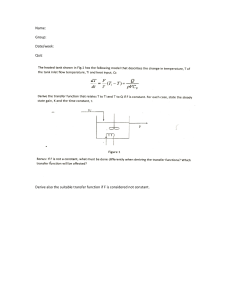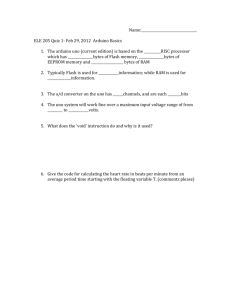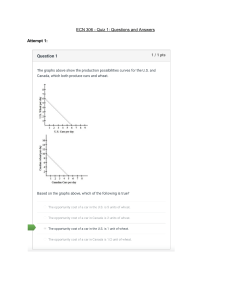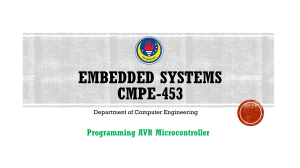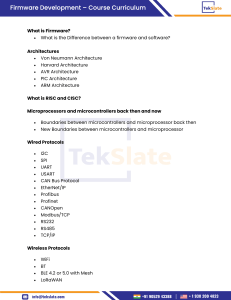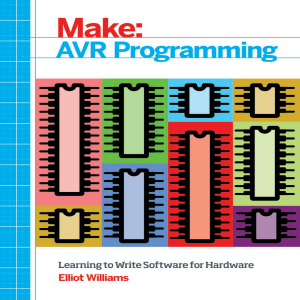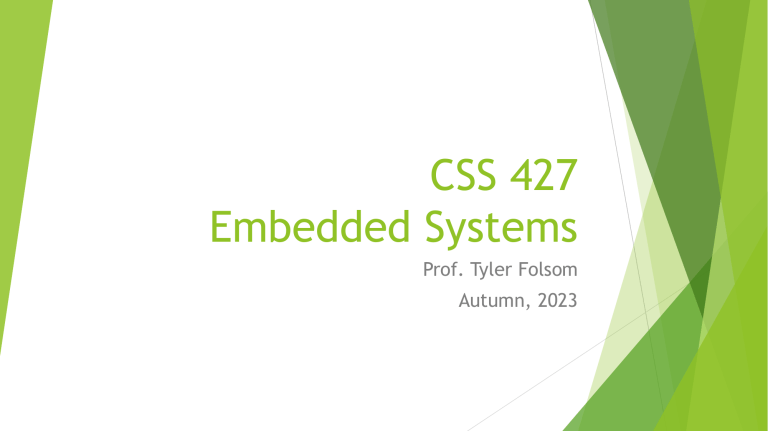
CSS 427 Embedded Systems Prof. Tyler Folsom Autumn, 2023 Syllabus The introductory course is based on the popular 8-bit Arduino microprocessor, programmed in C/C++ without an operating system. Instruction is heavily biased toward hands-on learning. Students work in small teams, and conclude with a selfselected project. System impacts are considered: is technology used in a way that promotes social justice? An example is to exploit the synergy between electric vehicles and automated vehicles to slow climate change and reduce pollution. EduScrum Previous classes were taught using eduScrum, a variation of the highly effective Scrum method for software development. CSS427 is organized into two sprints; objectives are tied to each sprint. EduScrum encourages students to be self-regulated learners. It gives the learning objectives, and encourages students to find the answer in the way that works best for them. We will use a variant in which students work in teams. Base outline A course schedule for lectures, labs and assignments is provided. Each 4-person team organizes itself to cover the learning objectives and include a method of assessing student progress. Teams are subdivided into pairs of lab partners. 12 workstations are available in the lab, each with a lab kit. Processor is Arduino AVR (8-bit 16 MHz) Uno or Mega. All tool chains also work with Arduino ARM Cortex M3 (32-bit 84 MHz) Due. Texts (Standard) AVR Programming: Learning to Write Software for Hardware, 1st Edition 2014, by Elliot Williams. ISBN13: 978-1449355784 (Alternative) The AVR Microcontroller and Embedded Systems Using Assembly and C: Using Arduino Uno and Atmel Studio; 2nd Edition 2017 by Sepehr Naimi, Sarmad Naimi and Muhammad Ali Mazidi ISBN-13: 978-0997925968; ISBN-10: 0997925965 (Last 2 weeks) Introduction to Embedded Systems: A Cyber-Physical Systems Approach; 2nd Edition; MIT Press; 2017 by Edward Lee & Sanjit Seshia https://ptolemy.berkeley.edu/books/leeseshia/ Effective Learning Less effective Highlighting or underlining Rereading material Moderately effective Generate explanations – Why is it true and how does it tie to what you know? Interleaved practice – Mix problems at random instead of one type at a time Highly effective Distributed practice – Study all subjects a little each day instead of cramming Testing yourself - Dunlosky et al. “What Works, What Doesn’t” Quizzes We will encourage the most effective learning methods There will be a quiz after each lecture, due before the next class Student teams are encouraged to test each other (before anyone has taken the quiz) Many quiz questions will be taken from Mazidi’s book. All quizzes are cumulative – you may see something we covered weeks ago. Teams are not allowed to disclose questions on the quiz It’s up to you “Learning results from what the student does and thinks, and only from what the student does and thinks. The teacher can advance learning only by influencing what the student does to learn.” - Herbert Simon

